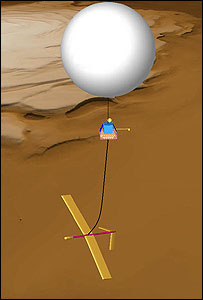The balloons will survey areas of interest for manned missions
Avi Blizovsky

Direct link to this page: https://www.hayadan.org.il/marsbaloon1.html
Remote-controlled balloons carrying an army of robot minions could fill the skies of Mars, if a project proposed by California scientists comes to fruition. NASA-funded research is developing a StratoSail - a winged balloon that can be precisely navigated in the sweeping winds of Mars for months.
Like weather balloons, the Stratosail will carry cameras and gadgets to observe potential areas for manned missions. The high-tech devices will also be able to launch robotic probes to monitor the surface of the ground.
The ability to build balloons that can last a long time and explore a planet and that can change their path in the atmosphere, launch vehicles into the terrain and transmit data to Earth, will be a very powerful tool for future research on Mars," said Dr. Alexey Pankin, a scientist at the Global Aerospace Corporation.
The balloons, or as they are called Directed Aerial Robot Explorers (Dares), will also be able to act as motherships that explore the planet for months. When needed, they could launch a fleet of baby robots and mini-labs to conduct experiments.
These balloons have long been used as a platform for observing the Earth because they are relatively cheap, consume very little energy and are multi-purpose.
Some of them even reached a place no balloon had explored before. In 1985, two balloons were sent to explore the atmosphere of Nega. However, researchers realized that there is a problem in stabilizing and controlling these aircraft in different atmospheres, especially those with strong wind currents.
Stratosail will overcome these problems by using light wings that will be used for stabilization, which will be tied a few kilometers below the balloon. The wind forces they will produce, due to the distance between the balloon and the wing, will move the entire device at a speed of one meter per second, explains Dr. Pankin.
Using such sail technology means that the device will not sink due to the weight of a power-guzzling engine. The researchers, funded by NASA's Institute for Innovative Concepts, are still in the early stages of development. Dr. Funkin and his team presented their research at the Balloon Technology and Space Applications Forum in Albuquerque on Tuesday this week.
Spacecraft expert - the next generation
Yadan Adamim - preparation for manned flights
For news at the BBC
https://www.hayadan.org.il/BuildaGate4/general2/data_card.php?Cat=~~~762653298~~~9&SiteName=hayadan
